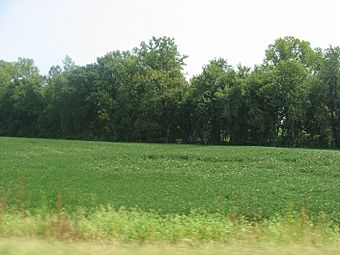Ashworth Archaeological Site facts for kids
The Ashworth Archaeological Site is an important ancient site in the very southwestern part of Indiana. It is located where the Ohio River and Wabash River meet. This area has many other similar ancient sites.
Archaeologists first studied the Ashworth site in the mid-1900s. They found it was once a village of Native Americans from a more recent time period. Because of its historical value, it has been named a historic site.
Contents
Where is the Ashworth Site?
The Ashworth Archaeological Site is in Point Township, which is the southwesternmost part of Posey County. It is about 1 mile (1.6 km) north of Hovey Lake. It is also about 1 mile (1.6 km) west of a bend in the Ohio River.
The site sits in a field on the east side of State Road 69. It is on top of a bluff, which is a high, steep cliff, overlooking a slough (a muddy channel or inlet).
Posey County has good weather with fewer frosty days than most of Indiana. It was also the first part of Indiana reached by people traveling up the Ohio River. Because of this, many ancient people lived in this area before Europeans arrived. In 1949, a study found evidence of fifteen different prehistoric villages in Point Township.
Discovering the Past

In 1945, the Indiana state government gave money to the Indiana State Library and Historical Bureau. This was because the United States Army Corps of Engineers was planning to build a large levee (a wall to prevent floods) along the Ohio River. Archaeologists worried this would destroy many ancient sites.
So, the Historical Bureau paid for a big study of Posey County. This study took place from April to December 1946. More studies continued into 1947, and the results were published in 1949.
In early 1947, the researchers visited a field in Point Township. This field was known for having many ancient objects. The owner had just plowed the field to plant corn. This brought many artifacts to the surface, making them easy to see.
The researchers found many items, including:
- Small pieces of stone from tool-making (lithic flakes)
- Pieces of ancient pottery (sherds)
- Parts of ancient human bones
What Archaeologists Found
By carefully looking at the surface of the field, the researchers collected 43 pottery pieces. Most of these (36) were "shell-tempered," meaning they had crushed shells mixed in. They also found a projectile point (like an arrowhead), seven scrapers, and four other stone tools. They even found a finger or toe bone from a large animal, like a cow or a bison.
After finding so many important items, the researchers asked for permission to dig up any ancient human burials they found. One day, they found a group of three ancient skeletons. These were a child and two adults (one male and one female). They were found because the owner's plowing had uncovered the leg bones of the adult male.
The bodies were buried in a shallow, rectangular grave on a slope. Their heads were pointing in a northwest direction. The archaeologists covered the skeletons for the night, planning to continue their work the next day.
However, when they returned, the owner had changed his mind. His religious beliefs led him to decide that no more digging should happen. So, after the archaeologists quickly sketched the skeletons, they respectfully reburied them as the owner asked.
What We Learned from Ashworth
Based on what they found, the 1940s study concluded that Ashworth was once an ancient village. The artifacts help us understand the people who lived there. Shell-tempered pottery is a special sign of the Mississippian culture.
Today, we believe the people who lived at Ashworth were part of the Caborn-Welborn culture. This was a group within the larger Mississippian culture. Very similar findings were made at a nearby site called 12PO11. Because the artifacts were alike and the sites were so close, 12PO11 might have been an outer part of the Ashworth village.
In 1985, about 50 acres (20 hectares) of the Ashworth Archaeological Site were added to the National Register of Historic Places. This is because of its important archaeological value. It is one of five archaeological sites in Posey County listed on the Register.
Images for kids






